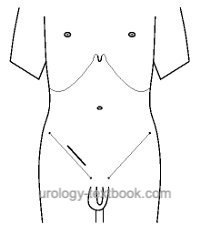You are here: Urology Textbook > Urologic surgery > Inguinal incision
Inguinal Incision: Steps of the Surgical Approach
Urologic Indications
In urology, an inguinal incision is used for radical orchiectomy, hernia repair, surgery for cryptorchidism, and varicoceles.
 |
Patient Positioning
Supine position.
Surgical Technique of an Inguinal Incision
- Incise the skin 1 cm above and parallel to the inguinal ligament, from the inner to the outer inguinal ring [fig. inguinal incision].
- Cut through the subcutaneous fat tissue and Camper fascia to expose the aponeurosis of the external oblique muscle of the abdomen.
- Transsect the aponeurosis of the external oblique muscle from the external inguinal ring to the level of the internal inguinal ring. Identify the ileoinguinal nerve to facilitate preservation.
- Mobilize the spermatic cord to the internal inguinal ring by blunt and sharp dissection.
| Do you want to see the illustration? Please support this website with a Steady membership. In return, you will get access to all images and eliminate the advertisements. Please note: some medical illustrations in urology can be disturbing, shocking, or disgusting for non-specialists. Click here for more information. |
| Do you want to see the illustration? Please support this website with a Steady membership. In return, you will get access to all images and eliminate the advertisements. Please note: some medical illustrations in urology can be disturbing, shocking, or disgusting for non-specialists. Click here for more information. |
| Do you want to see the illustration? Please support this website with a Steady membership. In return, you will get access to all images and eliminate the advertisements. Please note: some medical illustrations in urology can be disturbing, shocking, or disgusting for non-specialists. Click here for more information. |
Wound Closure:
Fascial closure with continuous running (monofilament, elastic, slowly absorbable, suture size USP 2-0) or interrupted sutures.
| Gibson incision | Index | Subinguinal incision |
Index: 1–9 A B C D E F G H I J K L M N O P Q R S T U V W X Y Z
References
J. A. Smith, S. S. Howards, G. M. Preminger, and R. R. Dmochowski, Hinman’s Atlas of Urologic Surgery Revised Reprint. Elsevier, 2019.
 Deutsche Version: Leistenschnitt
Deutsche Version: Leistenschnitt
Urology-Textbook.com – Choose the Ad-Free, Professional Resource
This website is designed for physicians and medical professionals. It presents diseases of the genital organs through detailed text and images. Some content may not be suitable for children or sensitive readers. Many illustrations are available exclusively to Steady members. Are you a physician and interested in supporting this project? Join Steady to unlock full access to all images and enjoy an ad-free experience. Try it free for 7 days—no obligation.
New release: The first edition of the Urology Textbook as an e-book—ideal for offline reading and quick reference. With over 1300 pages and hundreds of illustrations, it’s the perfect companion for residents and medical students. After your 7-day trial has ended, you will receive a download link for your exclusive e-book.